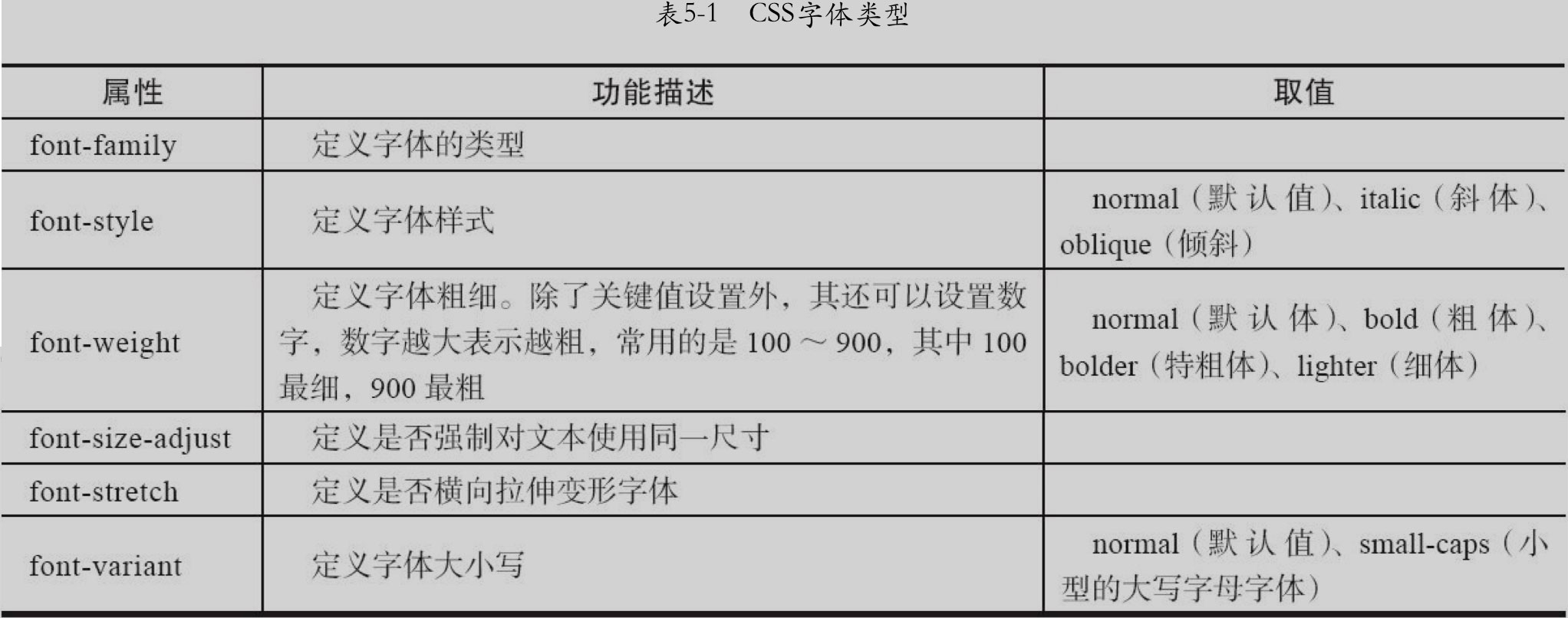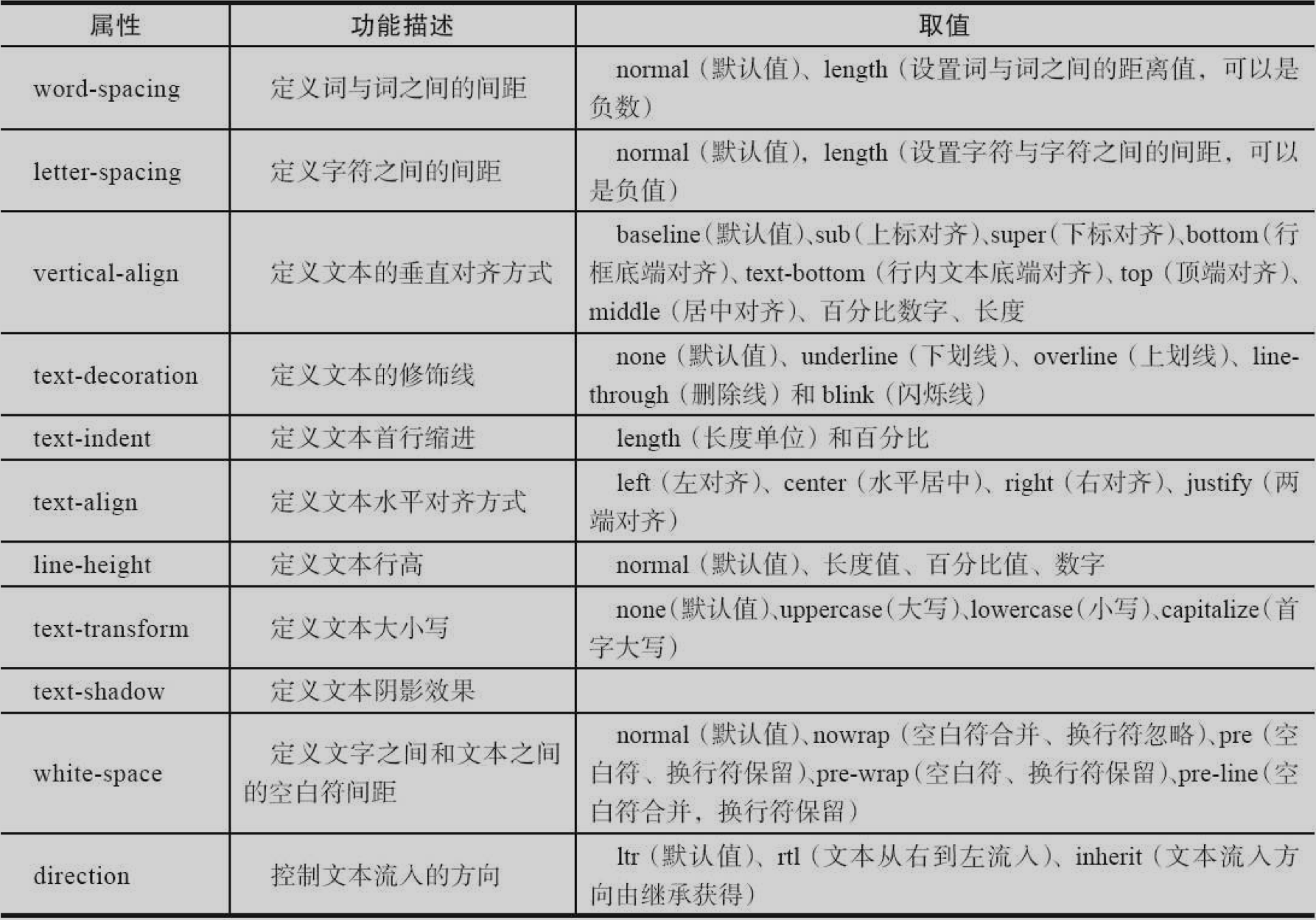1.CSS早期属性,分为三大类:字体、颜色和文本:

2.CSS文本类型有11个属性:

注:还有一个颜色属性:color,主要用来设置文本颜色
3.CSS3文本阴影属性:text-shadow
语法:text-shadow:none |
color:阴影颜色,定义绘制阴影是所使用的颜色,这个参数可以放在第一也可以放在最后,是一个可选参数,如果没有将使用文本颜色作为阴影颜色,可以是:颜色关键词、十六进制颜色、RGB颜色、RGBA透明色等
x-offset:X轴位移,用来指定阴影水平位移量,其值可以是正负值,为正值,阴影在对象的右边,反之阴影在对象的左边
y-offset:Y轴位移,用来指定阴影垂直方向偏移量,其值可以是正负值,如果为正值,阴影在对象的底部,反之阴影在对象的顶部
blur-radius:阴影模糊半径,可选参数,用来设置阴影的模糊半径,代表阴影向外模糊的模糊范围。这个值越大,阴影向外模糊的范围越大,阴影的边缘就越模糊。不过这个值只能是正值,其值为0时,表示阴影不具有模糊效果
注:可以指定多个阴影,并且可以独立调整。指定多个阴影时使用逗号将多个阴影进行分隔。多个阴影效果按照给定的顺序应用,因此前面的阴影有可能会覆盖后面的,但是但是永远不会覆盖文本本身
浏览器兼容性

IE的兼容问题,只好使用滤镜filter:shadow来处理。filter:shadow滤镜作用与dropshadow类似,也能是对象产生阴影效果,不同的是dropshadow可以产生渐进效果,是阴影显得更平滑细腻
E {filter:shadow(Color=颜色值, Direction=数值, Strength=数值)}
浏览器兼容性
IE的兼容问题,只好使用滤镜filter:shadow来处理。filter:shadow滤镜作用与dropshadow类似,也能是对象产生阴影效果,不同的是dropshadow可以产生渐进效果,是阴影显得更平滑细腻
E {filter:shadow(Color=颜色值, Direction=数值, Strength=数值)}
E是元素选择器
Color用于设定对象的阴影颜色
Direction用于设定投影的方向,取值为0度,阴影在文本上面;45度,阴影在文本右上角;90度,阴影在文本右边;135度,阴影在文本右下角;180度,阴影在文本下方;225度,阴影在文本左下方;270度,阴影在文本左边;315度,阴影在文本左上方
Strength就是阴影强度,类似于text-shadow的模糊半径
注:滤镜制作阴影效果和text-shadow制作效果相差甚远
4.CSS3溢出文本属性:text-overflow
语法及参数:text-overlfow:clip | ellipsis
只有两个属性值:
clip:不显示省略标记(···),只是简单的裁切
ellipsis:文本溢出时显示省略标记(···),省略标记插入的位置是最后一个字符
要想实现文本溢出时裁切文本显示省略标记(···)效果,还需要两个属性的配合;强制文本在一行显示(white-space:nowrap)和溢出内容隐藏(overflow:hidden),并且需要定义容器的宽度
浏览器兼容性

注:text-overflow属性在IE系列下得到较好的支持,直到Firefox 6才开始支持text-overflow:ellipsis属性的应用,而Opera浏览器下还需要加其独有的前缀【-o-】才能识别
5.CSS3文本换行
浏览器自身都带有让文本换行的功能。对于西方文本来说,浏览器会在半角空格或连字符的地方自动换行,而不会在单词的中间突然换行;对于中文来说,可以在任何一个文字后面换行,但浏览器碰到标点符号时,通常将标点符号和标点前面的一个文字作为一个整体统一换行
white-space属性,用来禁止文本换行
word-wrap属性,器属于IE的专有属性
有时文本不会自动换行,解决办法:
(1)overflow:auto,用滚动条来控制
(2)overflow:hidden,直接隐藏掉,来达到布局的完美性
(3)通过Javascript脚本来控制
(4)使用CSS3新属性word-wrap属性
word-wrap属性
在CSS3中,使用word-wrap属性实现长单词与URL地址的自动换行
语法及参数:word-wrap:normal | break-word
normal:默认值,浏览器只在半角空格或连字符的地方进行换行。
break-word:将内容在边界内换行(不截取英文单词换行),长文本和URL地址都自动换行了,唯一不完美的是,它不会按单词换行,直接将长单词截断换行,增加阅读的难度
注:word-wrap应用在
和
 Difficulty in updating caching of official account web pages: How to avoid the old cache affecting the user experience after version update?Mar 04, 2025 pm 12:32 PM
Difficulty in updating caching of official account web pages: How to avoid the old cache affecting the user experience after version update?Mar 04, 2025 pm 12:32 PMThe official account web page update cache, this thing is simple and simple, and it is complicated enough to drink a pot of it. You worked hard to update the official account article, but the user still opened the old version. Who can bear the taste? In this article, let’s take a look at the twists and turns behind this and how to solve this problem gracefully. After reading it, you can easily deal with various caching problems, allowing your users to always experience the freshest content. Let’s talk about the basics first. To put it bluntly, in order to improve access speed, the browser or server stores some static resources (such as pictures, CSS, JS) or page content. Next time you access it, you can directly retrieve it from the cache without having to download it again, and it is naturally fast. But this thing is also a double-edged sword. The new version is online,
 How do I use HTML5 form validation attributes to validate user input?Mar 17, 2025 pm 12:27 PM
How do I use HTML5 form validation attributes to validate user input?Mar 17, 2025 pm 12:27 PMThe article discusses using HTML5 form validation attributes like required, pattern, min, max, and length limits to validate user input directly in the browser.
 How to efficiently add stroke effects to PNG images on web pages?Mar 04, 2025 pm 02:39 PM
How to efficiently add stroke effects to PNG images on web pages?Mar 04, 2025 pm 02:39 PMThis article demonstrates efficient PNG border addition to webpages using CSS. It argues that CSS offers superior performance compared to JavaScript or libraries, detailing how to adjust border width, style, and color for subtle or prominent effect
 What are the best practices for cross-browser compatibility in HTML5?Mar 17, 2025 pm 12:20 PM
What are the best practices for cross-browser compatibility in HTML5?Mar 17, 2025 pm 12:20 PMArticle discusses best practices for ensuring HTML5 cross-browser compatibility, focusing on feature detection, progressive enhancement, and testing methods.
 What is the purpose of the <datalist> element?Mar 21, 2025 pm 12:33 PM
What is the purpose of the <datalist> element?Mar 21, 2025 pm 12:33 PMThe article discusses the HTML <datalist> element, which enhances forms by providing autocomplete suggestions, improving user experience and reducing errors.Character count: 159
 What is the purpose of the <meter> element?Mar 21, 2025 pm 12:35 PM
What is the purpose of the <meter> element?Mar 21, 2025 pm 12:35 PMThe article discusses the HTML <meter> element, used for displaying scalar or fractional values within a range, and its common applications in web development. It differentiates <meter> from <progress> and ex
 How do I use the HTML5 <time> element to represent dates and times semantically?Mar 12, 2025 pm 04:05 PM
How do I use the HTML5 <time> element to represent dates and times semantically?Mar 12, 2025 pm 04:05 PMThis article explains the HTML5 <time> element for semantic date/time representation. It emphasizes the importance of the datetime attribute for machine readability (ISO 8601 format) alongside human-readable text, boosting accessibilit
 What is the purpose of the <progress> element?Mar 21, 2025 pm 12:34 PM
What is the purpose of the <progress> element?Mar 21, 2025 pm 12:34 PMThe article discusses the HTML <progress> element, its purpose, styling, and differences from the <meter> element. The main focus is on using <progress> for task completion and <meter> for stati


Hot AI Tools

Undresser.AI Undress
AI-powered app for creating realistic nude photos

AI Clothes Remover
Online AI tool for removing clothes from photos.

Undress AI Tool
Undress images for free

Clothoff.io
AI clothes remover

AI Hentai Generator
Generate AI Hentai for free.

Hot Article

Hot Tools

SAP NetWeaver Server Adapter for Eclipse
Integrate Eclipse with SAP NetWeaver application server.

EditPlus Chinese cracked version
Small size, syntax highlighting, does not support code prompt function

Dreamweaver Mac version
Visual web development tools

Notepad++7.3.1
Easy-to-use and free code editor

VSCode Windows 64-bit Download
A free and powerful IDE editor launched by Microsoft








